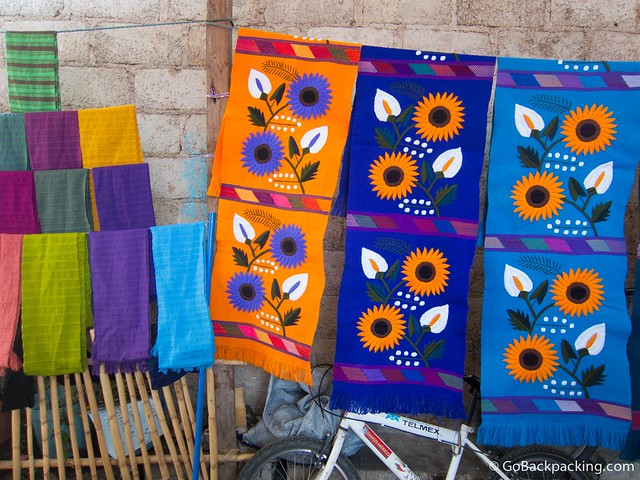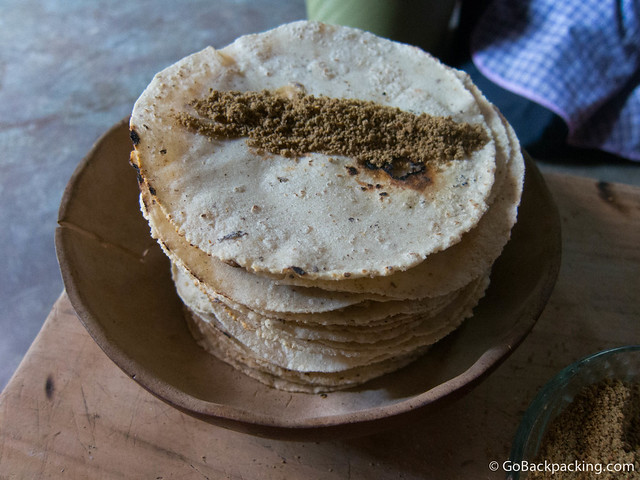We arrived bleary-eyed in San Cristobal de las Casas after the overnight bus ride from Oaxaca. Our G Adventures CEO, Gaby, recommended booking a half-day tour of San Juan Chamula and another Mayan village.
Specifically, the morning tour would free up our afternoon and the following day to do whatever we wanted.
She warned us that our local guide could be a bit intense, but it was out of a sense of duty to protect the local culture.

I'm sure that also implied keeping the villagers happy because they could quickly end the tours if the problems they created outweighed the revenue being generated.
The cost of the four-hour tour is 200 Mexican pesos ($15), with a portion going to each of the villages visited.
We all agreed, and after breakfast, met with other travelers near San Cristobal's cathedral.
From there, we met our local guide and boarded a minivan for the 10km drive to the first village, San Juan Chamula.
San Juan Chamula
We stopped short of the town center to visit a graveyard surrounding an abandoned church.
Villagers were attending one of the graves, and our guide took the opportunity to talk to us about photography.
He said it was OK to take photos of them from afar, but not up close.
This first opportunity was an easy call for me. I prefer not to take photos of anyone visiting a gravesite, regardless of the country or culture.
Instead, I focused on the graves themselves, decorated with flower-bearing wooden crosses.

After a brief stop at a villager's souvenir shop, where we learned about various forms of local dress, we walked for about ten minutes to the central plaza.
Located 2,200 meters (7,200 feet) above sea level in the Chiapas Highlands, San Juan Chamula boats a population of about 50,000 people.
One of the most interesting things about the village is its autonomy from the rest of Mexico.
For example, common Mexican laws do not apply here, nor do Mexico's police or army patrol here.
Chamula has its own police force and some eye-opening forms of justice.
Our guide made it a point to show us the jail, whose cell features a “window” out onto the street. Prisoners are kept no more than one day in prison.
That might seem like a light sentence, but justice is also served in a more Draconian fashion.
He explained that a few weeks earlier, three men attempted to steal a car.
One of them was caught and burned alive on the spot to warn others not to steal.
That story caught all of our attention based on the speed and severity of punishment.
Lesson: don't mess with Chamula.
Another interesting facet of village life in Chamula is the mix of Catholic and ancient Mayan religious traditions.
The church of San Juan Chamula looks normal from the outside, with its whitewashed walls, but the interior is unlike anything I'd ever seen.
And I've walked through hundreds of churches and cathedrals in my travels.
Before entering, our guide instructed us that absolutely no photographs were allowed because the indigenous Tzotzil Maya people believe cameras could steal their souls.
Not only could we not take photos, but we also had to make sure our cameras were either in our pockets or for those with DSLRs, that they were in a bag or otherwise covered.
The church is incredibly dark inside, with lighting provided by hundreds of candles.
The floor is covered in pine needles. There are no pews, which makes it one big open space.
Both walls are lined with religious figures in wooden and glass cases.
In front of the various figures are villagers of all ages lighting candles of multiple colors.
Our guide informed us the colors of the candles coincide with the colors of corn: red, black, yellow, and white, plus green (which represents Earth).
Some are there with shamans, or medicine men, who perform elaborate ceremonies to help them or their family members overcome problems, such as illness.
The shaman also uses sodas of various colors.
While it seems odd for Coca-Cola and Fanta to be used in a religious ceremony, our guide suggested it may be the color of the soda they're after and that in the past, they may have used corn-based drinks instead.
The shamans sacrifice chickens in the church. One of the travelers in our group saw such a chicken awaiting its demise.
Upon exiting the church, we were given 15 minutes to walk around the plaza on our own.
Of course, I took this time to buy ice cream and contribute to the local economy.

San Lorenzo Zinacantán
The second Mayan village we visited was Zinacantán, 7km west of San Juan Chamula.
Our first stop was a family home where souvenir textiles were produced.
The invitation to sit in the kitchen was more interesting to me than the textiles—one of the ladies cooked up fresh tortillas.


The tortillas would've been bland by themselves, but they also offered us a mixture of crushed pumpkin seed and salt to spread across them.
Once you rolled up the tortilla and bit into it, the pumpkin seed melted in your mouth, offering plenty of flavors to go along with the tortillas.
It was incredibly simple, yet very tasty, and a combination I'd never been offered before.

Once we'd had our fill of tortillas, we took a brief walk through the Church of Zinacantán, which looked similar on the inside to Western-style churches.
The pews, sunlight, and lack of shamans and sacrificial chickens presented a stark contrast to the religious traditions in nearby Chamula.
___
My Mexico Ancient Civilizations tour was in partnership with G Adventures. Any opinions expressed are entirely my own.
Dave is the Founder and Editor in Chief of Go Backpacking and Feastio. He's been to 66 countries and lived in Colombia and Peru. Read the full story of how he became a travel blogger.
Planning a trip? Go Backpacking recommends:
- G Adventures for small group tours.
- Hostelworld for booking hostels.

Anil
Wednesday 28th of August 2013
The inside of the Church of San Juan Chamula is one of the most incredible sights I've seen anywhere. Wish photos and video were allowed.
Dave
Thursday 29th of August 2013
Not being able to take photos made me want to take them even more than usual! But, at the end of the day, I respect their reasons for not allowing it.
Andi of My Beautiful Adventures
Wednesday 21st of August 2013
Those tortillas sound amazing! I've heard great stuff about this town.
fred mucai
Tuesday 20th of August 2013
No Mexican laws at The Mayan Village of San Juan Chamula!! amazing. I wonder what the interesting forms of justice are? I hope not too severe.
Dave
Tuesday 20th of August 2013
Not sure if you missed it in the article, but I included an example of a thief being burned alive by villagers. That's extreme justice.